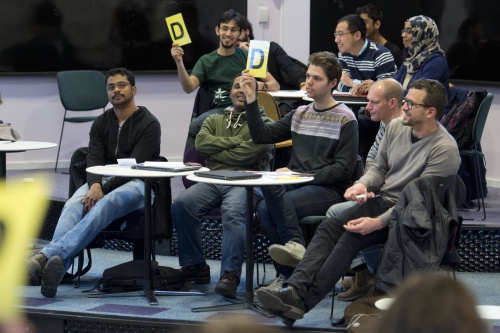Active teaching
A teacher wrote to me: “Why students need to read the materials before going to class? What is wrong with lecturing? Is there evidence that active learning better than lecturing? How does it work in literature or history courses Please explain.”
Answer: I teach science and technology and have been using active learning method for many years. It works well for me and my students. I do NOT know how this method can be applied to other subjects such as history, sociology or literature etc. After all, as the teachers, we select which method is best for our students and it is our choice.
In my class, I ask students to read the assigned materials or watch a short video BEFORE coming to class. At the beginning of each class, I spend about 10 minutes on a short quiz to make sure students do read the materials or watch a video so they are prepared to participate in the class discussion. About 5 minutes before the end of the class, I also ask them to fill out few short questions on how well they have learned on that class and identify things that they do not understand well or are still confused, to help me prepare for the next class.
When I began teaching about twenty-five years ago, I prepared my lecture carefully then found that I was only lecturing to a small number of students. Some students believed the lecture was difficult to understand when others found it was too easy to keep them interested. I learned quickly that the lecturing method was ineffective because there were different levels of students in the class. Some learned fast when others learned much slower. Some had a good foundation when others did not as students learned things differently. However, in a traditional classroom, most teachers continue to treat all students at the same level. Advanced students want the teachers to move faster because they already know the materials, if the lecture is slow they get bored. Other students want the teachers to move slower because they need more time to learn, if the lecture is fast, they get confused. In every class, some students learned well when other fell behind and not learned much. In that case, many may not develop the needed skills to succeed in the job market. When students do not learn well, some lose their confidence and even quit school.
I asked myself, how do I set the same level for all students? I began to experiment with the active learning method. I videotaped my lecture in an empty classroom using the same materials that I used to lecture and posted them online. Students can watch it, if needed, they can rewind it, and watch it again until they learn the materials well. Some students may watch it once but others may watch it many times as they wish. In class, I give a short lecture to summarize important concepts and use the class time for students to discuss, explore, solve problems so they can learn things at a deeper level. By have less time to lecture, I can ask questions to help students to learn more and know how well they are learning based on their answers. Before class, students can learn at their own pace by watching the videos or reading the materials based on their own. By the time they all come to class, most already know something so their level is more compatible with each other. In that case, I only need to answer questions, facilitate discussions, explore new concepts, and let students solving problems etc.
By using the Active learning method, students learn at their own speed according to their way of studying and responsible for their own learning. Since adopting this method, I saw a significant change in my students’ learning. Not only they learn much more than before, but they were able to reflect on their own learning process. Even lesser skilled students were advancing and caught up quickly to advanced students. Many of them were gaining confidence, and no longer feel stressed before the weekly quizzes. The best thing was not only they learned well in my class but also in other courses as they were developing a better way of learning.
Sources
- Blogs of Prof. John Vu, Carnegie Mellon University
